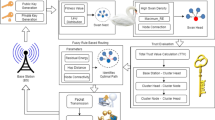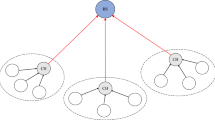Abstract
Wireless sensor network (WSN) is a special kind of ad-hoc network consists of battery powered low cost sensor nodes with limited computation and communication capabilities deployed densely in a target area. Clustering in WSN plays an important role because of its inherent energy saving capability and suitability for highly scalable network. This paper is an extended version of our previous work (Sahoo et al. 2013a). Although the clustering strategy presented in this paper is same as our previous work but here a light weight dynamic TRUST model along with honey bee mating algorithm is presented, which will only prevent malicious node to be a cluster head. The choice of light weight TRUST model makes our clustering method more secure and energy efficient, which are most pivotal issues for resource constrained sensor network. We have also introduced a priority scheme among the trust metrics which is more realistic. Furthermore, the use of honey bee mating algorithm finds most appropriate node as cluster head. Simulation results are also presented here to compare the performance of our algorithm with low energy adaptive clustering hierarchy and advertisement time-out driven bee mating approach to maintain fair energy level in sensor networks.









Similar content being viewed by others
References
Abbass HA (2001a) A monogenous MBO approach to satisfiability. In: Proceedings of international conference on computational intelligence for modeling, control and automation, Las Vegas, NV, USA
Abbass HA (2001b) Marriage in honey-bee optimization (MBO): a haplometrosis polygynous swarming approach. In: The congress on evolutionary computation, Seoul, Korea, pp 207–214
Afshar A, Haddada OB, Marino MA, Adams BJ (2007a) Honey-bee mating optimization (HBMO) algorithm for optimal reservoir operation. J Frankl Inst 344:452–462
Afshar A, Hadded OB, Marino MA, Adams BJ (2007b) Honey-bee mating optimization (HBMO) algorithm for optimal reservoir operation. In: Journal of the Franklin Institute, proceedings of the 2001 congress on evolutionary computation, vol 1, pp 452-462
Bao F, Chen I, Chang M, Cho J (2012) Hierarchical trust management for wireless sensor networks and its applications to trust-based routing and intrusion detection. IEEE Trans Netw Serv Manag 9(2):169–183
Crosby GV, Pissinou N, Gadze J (2006a) A framework for trust-based cluster head election in wireless sensor networks. In: Proceedings of second IEEE workshop on dependability and security in sensor networks and systems
Crosby GV, Pissinou N, Gadze J (2006b) A framework for trust-based cluster head election in wireless sensor networks. In: Proceedings of second IEEE workshop on dependability and security in sensor networks and systems, pp 10–22
de Castro LD, Timmis J (2002) Artificial immune systems: a new computational intelligence approach. Springer, Heidelberg
Dorigo M, Stutzle T (2004) Ant colony optimization. A Bradford book. The MIT Press Cambridge, Massachusetts, London, England
Fathian M, Amiri B, Maroosi A (2007) Application of honey bee mating optimization algorithm on clustering. Appl Math Comput. doi:10.1016/j.amc.2007.02.029
Ferdous R, Muthukkumarasamy V, Sithirasenan E (2011) Trust-based cluster head selection algorithm for mobile ad hoc networks. In: Proceedings of international joint conference on IEEE TrustCom-1111/IEEE ICESS-11/FCST-11, pp 589–596
Heinzelman WB, Chandrakasan AP, Balakrishnan H (2002) An application-specific protocol architecture for wireless micro sensor networks. IEEE Trans Wirel Commun 1(4):660–670
Hur J, Lee Y, Yoon H, Choi D, Jin S (2005) Trust evaluation model for wireless sensor networks. In: The 7th international conference on advanced communication technology, Gangwon-Do, Korea
Kumar D, Aseri TC, Patel RB (2009) EEHC: energy efficient heterogeneous clustered scheme for wireless sensor networks. Comput Commun 32(4):662–667
Li X, Zhou F, Junping D (2013) LDTS: a lightweight and dependable trust system for clustered wireless sensor networks. IEEE Trans Inform Forensic Secur 8(6):924–935
Manjeshwar A, Agrawal DP (2001) TEEN: a protocol for enhanced efficiency in wireless sensor networks. In: Proceedings of international workshop on parallel and distributed computing issues in wireless networks and mobile computing, San Francisco, CA, April
Manjeshwar A, Agrawal DP (2002) APTEEN: a hybrid protocol for efficient routing and comprehensive information retrieval in wireless sensor networks. In: Proceedings of international parallel and distributed processing symposium
Marinakis Y, Marinaki M, Matsatsinis N (2007) A hybrid clustering algorithm based on honey bees mating optimization and greedy randomized adaptive search procedure. In: Proceedings of second international conference, LION 2007 II, Trento, Italy, December 8–12
Momani M (2008) Bayesian methods for modeling and management of trust in wireless sensor networks. Ph.D Thesis, University of Technology, Sydney, July
Momani M, Challa S (2010) Survey of trust models in different network domains. Int J Ad Hoc Sensor Ubiquitous Comput 1(3):1–19
Sahoo RR, Sardar AR, Singh M, Ray S, Kumar S (2013a) Trust based secure and energy efficient clustering in wireless sensor network: a bee mating approach. In: PReMI 2013, LNCS 8251, Springer, Berlin, Heidelberg, pp 100–107
Sahoo RR, Singh M, Sahoo BM, Majumder K, Ray S, Sarkar SK (2013b) A lightweight trust based secure and energy efficient clustering in wireless sensor network: honey bee mating intelligence approach. In: Proceedings of international conference on computational intelligence: modeling techniques and applications, procedia technology, Elsevier, pp 27–28
Saleem M, Khayam SA, Farooq M (2008) Formal modeling of bee adhoc: a bio-inspired mobile ad hoc network routing protocol. In: Proceedings of GECCO
Senthilkumar J, Chandrasekaran M (2011) Improving the performance of wireless sensor network using bee’s mating intelligence. Eur J Sci Res 55(3):452–465
Senthilkumar J, Chandrasekaran M, Suresh Y, Arumugam S, Mohanraj V (2011) Advertisement timeout driven bee’s mating approach to maintain fair energy level in sensor networks. Appl Soft Comput 11(5):4029–4035
Shaikh RA, Jameel H, d’Auriol BJ, Lee H, Lee S (2009) Group-based trust management scheme for clustered wireless sensor networks. IEEE Trans Parallel Distrib Syst 20(11):1698–1712
Wedde H, Farooq M, Pannenbaecke T, Vogel B, Mueller C, Meth J, Jeruschkat R (2005) BeeAdHoc: an energy efficient routing algorithm for mobile ad hoc networks inspired by bee behavior. In: Proceedings of GECCO
Younis O, Fahmy S (2004) HEED: a hybrid energy-efficient distributed clustering approach for ad-hoc sensor networks. IEEE Trans Mobile Comput 3(4):366–379
Zahariadis T, Leligou HC, Trakadas P, Voliotis S (2010) Trust management in wireless sensor networks. Eur Trans Telecommun 21:386–395
Acknowledgments
Rashmi Ranjan Sahoo thankfully acknowledges the financial support obtained from TEQIP-II programme by Ministry of Human Resource and Development, India.
Author information
Authors and Affiliations
Corresponding author
Additional information
This work is partly sponsored by TEQIP-II, MHRD India.
Rights and permissions
About this article
Cite this article
Sahoo, R.R., Sardar, A.R., Singh, M. et al. A bio inspired and trust based approach for clustering in WSN. Nat Comput 15, 423–434 (2016). https://doi.org/10.1007/s11047-015-9491-8
Published:
Issue Date:
DOI: https://doi.org/10.1007/s11047-015-9491-8




